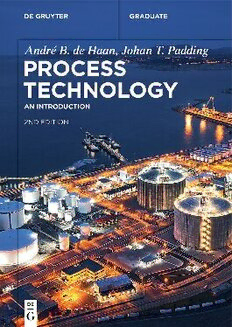
Process Technology: An Introduction PDF
Preview Process Technology: An Introduction
AndréB.deHaan,JohanT.Padding ProcessTechnology Also of Interest IndustrialSeparationProcesses. Fundamentals DeHaan,Real,Schuur, ISBN----,e-ISBN---- ChemicalReactionTechnology Murzin, ISBN----,e-ISBN---- ReactiveDistillation. AdvancedControlusingNeuralNetworks Sakhre,Singh, ISBN----,e-ISBN---- SustainableProcessEngineering Szekely, ISBN----,e-ISBN---- ChemicalReactionEngineering. AComputer-AidedApproach Salmi,Wärnå,HernándezCarucci,deAraújoFilho, ISBN----,e-ISBN---- André B. de Haan, Johan T. Padding Process Technology An Introduction 2nd Edition Authors Prof.Dr.Ir.AndréB.deHaan DepartmentofChemicalEngineering DelftUniversityofTechnology SectionTransportPhenomena VanderMaasweg9 2629HZDelft Netherlands Prof.Dr.JohanT.Padding FacultyofMechanical,MaritimeandMaterialsEngineering DelftUniversityofTechnology Leeghwaterstraat39 2628CBDelft Netherlands ISBN978-3-11-071243-8 e-ISBN(PDF)978-3-11-071244-5 e-ISBN(EPUB)978-3-11-071246-9 LibraryofCongressControlNumber:2021951791 BibliographicinformationpublishedbytheDeutscheNationalbibliothek TheDeutscheNationalbibliothekliststhispublicationintheDeutscheNationalbibliografie; detailedbibliographicdataareavailableontheInternetathttp://dnb.dnb.de. ©2022WalterdeGruyterGmbH,Berlin/Boston Coverimage:Mimadeo/iStock/GettyImagesPlus Typesetting:IntegraSoftwareServicesPvt.Ltd. Printingandbinding:CPIbooksGmbH,Leck www.degruyter.com Preface Multidisciplinarycooperation isoneof the key contributorsto successful innovation andprojectexecutionwithinthecurrentandfutureprocessindustry.Themainchal- lengewithinmultidisciplinaryteamsiscommunication,whichwillbemuchmoreef- fective whenpossessingbasic understandingofeachother’s discipline. It isexactly thisreason, enhancing the understanding of processtechnology by those without a background in (bio)chemical process engineering, that has motivated us to create thesecondeditionofthisbook.Thefirsteditionservedasthebasisfortheindustrial course“IntroductionintotheWorldofProcessTechnology,”whichhasbeengivenfor manyyearswithinmultiplemultinationalcompanies.Participantsincludedchemists (organic/catalytic/bio/physical/analytical), material technologists, economists, ac- countants, lawyers and many others working in a position where cooperation and communication with (bio)chemical process engineers was an essential part of their job.Since2020thecoursehasbeenrevivedandisnowprovidedas“ProcessTechnol- ogyforNon-processTechnologists”bytheTUDelftProcess&ProductTechnologyIn- stitute(www.tudelft.nl/Pro2Tech).Besides small revisions/correctionsthroughout all chaptersandanupdateofreferencesforfurtherreading,thissecondeditionnowin- cludeselectrochemicalconversion,amorecompleteoverviewofcomputationalfluid dynamicsapproachesandmorebackgroundoneconomicevaluationofprojects. The main objective of this book is to provide a general overview of chemical and biochemical process and product technology. It focuses on the structure and development of production processes, main technological operations and the most importantaspectsofproductandprocessdevelopment,includingeconomics.Forthe technological operations, the emphasis is on their operating principles, reasons for applicationandavailableindustrialequipment.Designcalculationsandmathematics havebeenkepttoaminimumrequiredtounderstandwhyprocesstechnologistsand engineersneedcertaininformation.Alltopicsareextensivelyillustratedbyrepresen- tativeexamples. Thebookisorganizedintosevendistinctparts.Anintroductiontothestructure ofthechemicalindustryand(bio)chemicalprocessesistreatedinChapters1and2. Chapters3–5dealwith(bio)chemicalreactionengineeringandreactortechnology. The most frequently applied molecular separation techniques such as distillation, extraction, absorption, stripping, adsorption and ion exchange are discussed in Chapters6–9.Thepartonmechanicalseparationtechnologypresentsanoverview of the most important techniques for separating heterogeneous mixtures in Chap- ters10–12.Technologiesrelevantforparticlesandfinalproductmanufacturingare treatedinChapters13–15.Chapters16–18dealwiththedevelopment,scale-up,de- sign,engineeringandsafetyofprocesses.Thebookconcludeswiththreeappendi- ces in which major industrial processes for the production of base chemicals, polymersandfinechemicalsaredescribed.Itshouldbenotedbythereaderthatthe appendicesonlyrepresentasmallselectionofthenumerousindustrialprocessesin https://doi.org/10.1515/9783110712445-202 VI Preface operation and that the described processes have been selected with a bias on the companies where the course was lectured. For further reading, an extensive list of referencebooksisprovided. AndréB.deHaan JohanT.Padding Contents Preface V 1 Thechemicalindustry 1 1.1 Introduction 1 1.2 Generalcharacteristicsofthechemicalindustrysegments 3 1.3 Majorrawmaterials 5 1.4 Productionstructureofthechemicalindustry 6 2 Thestructureofchemicalandbiochemicalprocesssystems 11 2.1 Structureofchemicalandbiochemicalprocesses 11 2.2 Characteristicsofproductionprocesses 12 2.2.1 Batchproductiontechnology 12 2.2.2 Continuousprocesses 13 2.3 Unitoperations 15 2.3.1 Reactors 16 2.3.2 Recovery,purificationandfractionationtechnologies 18 2.3.3 Productfinishingoperations 20 2.3.4 Otherimportantprocessunits 22 2.4 Processsynthesis 24 3 Principlesofchemicalreactionengineering 27 3.1 Introduction 27 3.2 Classificationofreactions 28 3.3 Rateofchemicalreactions 29 3.3.1 Effectofconcentration 29 3.3.2 Effectoftemperature 30 3.3.3 Chemicalequilibria 31 3.4 Catalysis 33 3.4.1 Homogeneouscatalysis 33 3.4.2 Heterogeneouscatalysis 35 3.5 Conversion,selectivtityandyield 37 3.5.1 Conversion 37 3.5.2 Selectivityandyield 38 3.5.3 Multistepreactions 39 3.6 Basicdesignequationsformodelreactors 41 3.6.1 Molarbalances 41 3.6.2 Theidealbatchreactor 42 3.6.3 Thecontinuousidealstirredtankreactor 44 3.6.4 Idealcontinuousplugflowreactor 45 3.6.5 Cascadeofcontinuousidealstirredtanksreactors 47 VIII Contents 3.7 Heateffectsinmodelreactors 48 3.7.1 Generalheatbalance 48 3.7.2 Heatbalanceinacontinuousidealstirredtankreactor 49 3.7.3 Heatbalanceinabatchreactor 50 4 Chemicalreactorsandtheirindustrialapplications 53 4.1 Introduction 53 4.1.1 Classificationofreactors 53 4.1.2 Influenceofheatofreactiononreactortype 53 4.2 Stirredtankreactors 54 4.2.1 Description 54 4.2.2 Batchstirredtankreactors 55 4.2.3 Continuousstirredtanks 57 4.2.4 Cascadeofstirredtanks 60 4.3 Tubularreactors 61 4.3.1 Introduction 61 4.3.2 Gas-phasereactors 62 4.3.3 Liquid-phasereactors 64 4.4 Loopreactors 65 4.4.1 Continuousloopreactors 66 4.4.2 Bussloopreactor 66 4.5 Bubblecolumns 68 4.6 Fixedandmovingbedreactors 70 4.6.1 Fixedbedreactors 70 4.6.2 Adiabaticfixedbedreactors 71 4.6.3 Fixedbedreactorswithsupplyorremoval ofheat 72 4.6.4 Movingbedreactors 74 4.7 Fluidizedbedreactors 75 4.7.1 Thefluidizationprinciple 76 4.7.2 Fluidizationpropertiesoftypicalbedsolids 78 4.7.3 Applications 78 4.8 Electrochemicalreactors 82 4.8.1 Basicelementsofanelectrochemicalreactor 82 4.8.2 Designofanelectrochemicalreactor 83 4.8.3 Applications 85 5 Biochemicalreactiontechnology 87 5.1 Characteristicsofbiochemicalprocesses 87 5.1.1 Fermentation 88 5.1.2 Enzymaticconversions 93 5.2 Biochemicalreactionengineering 96 Contents IX 5.2.1 Principles 96 5.2.2 Kineticsofbiochemicalreactions 96 5.2.3 Basicreactoroperations 100 5.3 Industrialbioreactors 102 5.3.1 Classification 102 5.3.2 Bioreactorswithmechanicalmixing 103 5.3.3 Bioreactorswithpneumaticmixing 104 5.3.4 Bioreactorsforimmobilizedenzymesandcells 106 6 Evaporativeseparations 109 6.1 Evaporativeseparation 109 6.1.1 Introduction 109 6.1.2 Vapor-liquidequilibria 110 6.1.3 Separationbysingle-stagepartialevaporation 113 6.2 Multistagedistillation 115 6.2.1 Distillationcascades 115 6.2.2 Columndistillation 116 6.2.3 Feasibledistillationconditions 118 6.2.4 Basicdesigncalculations 119 6.2.5 Energyrequirements 122 6.2.6 Batchdistillation 123 6.2.7 Continuousseparationofmultipleproducts 125 6.2.8 Enhanceddistillationtechniques 125 6.3 Distillationequipment 127 6.3.1 Basicfunctions 127 6.3.2 Traycolumns 128 6.3.3 Packedcolumns 132 6.3.4 Criteriaforcolumnselection 137 6.4 Polymerdevolatilization 137 6.4.1 Introduction 137 6.4.2 Basicmechanisms 138 6.4.3 Multistageoperationanddevolatilizationaids 140 6.4.4 Devolatilizationequipment 141 7 Extractionandleaching 147 7.1 Liquid-liquidextraction 147 7.1.1 Introduction 147 7.1.2 Liquid-liquidequilibria 149 7.1.3 Solventselection 151 7.1.4 Extractionschemes 152 7.2 Industrialliquid-liquidextractors 154 7.2.1 Mixersettlers 154
